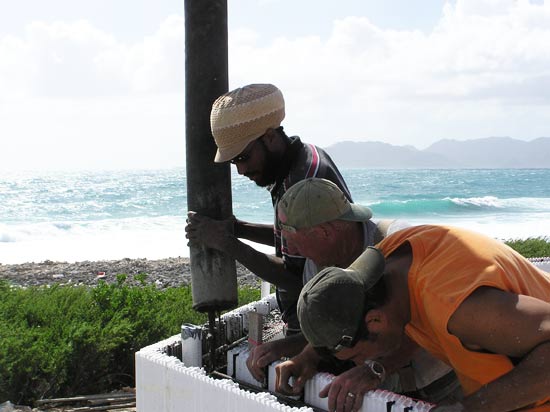-
WELCOME
General Information
Home Best Caribbean Island Anguilla Vacations Air Travel to Anguilla Car Rentals Weather -
SLEEP
-
REALTY & BUSINESS
-
THINGS TO DO
-
EAT
- SPECIAL
- KEEP IN TOUCH
- SAVE 10%
|
|
While all was a buzz with the big preparation for the major pour for our Anguilla home's main slab, Mike was also working around the clock coordinating and finalizing our order for the "ICF wall system".
As I mentioned before, there are three basic ways to build walls here in the Caribbean:
The first is the least popular due to the structural integrity, considering weather. The second is the norm, and the last is used for a variety of applications but certainly not everywhere.
Our ICF wall system uses the "concrete pour".
ICFs are "Insulting Concrete Forms", expanded polystyrene forms that are used in the erection of "Cast In Place" (CIP) concrete walls. Normally plywood is set to make a cast when the concrete is poured. After the pour, they are removed. But, in this case, the plywood is replaced with 2 1/2" thick polystyrene sheets (on both sides of the wall) and they remain there after the pour.
We chose this system for a few reasons...
The ICF system has been used in Europe, Japan, Canada and the United States for over 35 years. This system is becoming more and more popular in the Caribbean on islands such as Puerto Rico, Cayman Islands, Virgin Islands, Turks and Caicos and Antigua just to mention a few. We will be the first to successfully complete an ICF home in Anguilla, though!
There are over 50 manufacturers of ICF. Mike did his research and chose the best overall system! Because this technology is new to the island, Mike arranged a for a knowledgeable representative from Integraspec, the ICF company he selected, to come spend a week or so and provide training for our team.
All of the materials required fit in one 40 foot container. It arrived with Ernie (the Integraspec representative) who flew down from Canada to start the training...
First, the panels are assembled and stacked together like Lego blocks. Rebar is then introduced as the rows go up. Door and window openings are cut out of the wall surface and bucks are placed on the inside of these openings. "Bucks" help hold the concrete in place away from these openings.

The team really got it. They embraced the system quickly and seemed like old ICF pros in no time! The training couldn't have gone smoother.
The big question now?
How is foam going to hold up all of this concrete?
The only support here is a couple of metal support brackets placed in strategic locations. There are no sturdy snap ties, 2x4's or 4x4's either.

Even our concrete supplier, Irving Philips, was intrigued enough to make a couple of stops by the site. He talked with Ernie about the system, joking that foam is for coffee cups not concrete!
Ernie just laughed and reassured everyone that this is not the first time this has been done. And then, to really blow Irving's mind, he tells Irving that we will be pouring 10ft of concrete (high) in one shot. And, 8" thick.
Within a week of Ernie's arrival, the team was ready for the big pour. This one would be a far cry from pouring the main slab. The excitement built!
As the concrete started to flow, tension ran high. But before you know it, the crew switched into automatic mode, as if this process was second nature to them.
While the pour progressed, everyone kept a watchful eye...


The team was nervous about having a "blowout", when the concrete breaks through the form. The fear subsided and a couple of hours later?...

Another Happy Ending!

Mike and Ernie thanked West Indies Concrete for delivering perfect concrete in a timely matter.
Everyone was so proud. Mr. Irving and Ernie were so impressed, too!

Tranquility Beach
(Luxury Hotel & Residences)

Long Bay Villas:
The Ultra-Luxury Villas
Sky, Sea & Sand

Santosha Villa Estate:
Anguilla's Most Sophisticated
Ultra-Luxury Villa
Facebook Comments
Have your say about what you just read! Leave a comment in the box below.